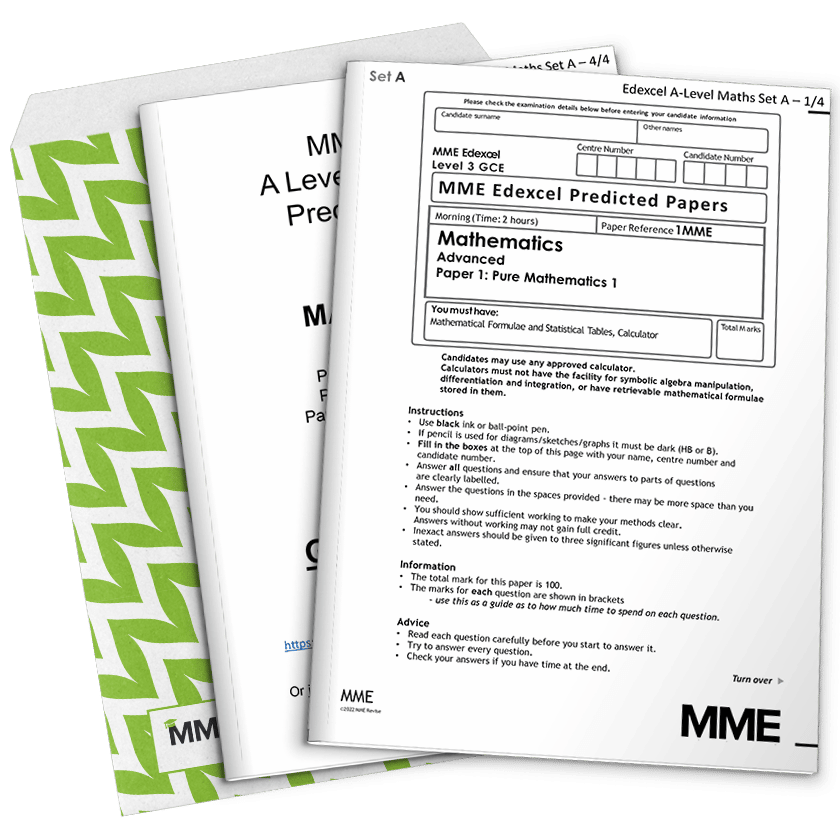Solving Quadratic Equations
Solving Quadratic Equations Revision
Solving Quadratic Equations
You can solve quadratic equations of the form ax^2 + bx + c = 0 through factorising, completing the square or using the quadratic formula.
Solving Quadratics through Factorising
The quickest and easiest way to solve quadratic equations is by factorising.
You need to be able to spot ‘disguised‘ quadratics involving a function of x, f(x), instead of x itself. You need to use the substitution y=f(x) and solve for y, and then use these to find the values of x.
Example: Solve x^2 + 2x = 15 through factorising.
Rearrange the equation into the form ax^2 + bx + c = 0:
x^2 + 2x - 15 = 0
Then, solve the equation by factorising:
(x-3)(x+5) = 0
So,
x - 3 = 0 \Rightarrow \textcolor{blue}{x = 3} and x + 5 = 0 \Rightarrow \textcolor{blue}{x = -5}
Completing the Square Method
The following method can be used to complete the square of a quadratic expression:
Step 1: Rearrange the quadratic in the form
ax^2 + bx + c
Step 2: Take out a factor of a out of the x^2 and x terms:
a \left( x^2 + \dfrac{b}{a} x \right) + c
Step 3: Halve the coefficient of x and rewrite the brackets as one squared bracket:
a \left(x + \textcolor{limegreen}{\dfrac{b}{2a}} \right)^2
Step 4: Add \textcolor{red}{d} to the bracket to complete the square:
a \left(x + \textcolor{limegreen}{\dfrac{b}{2a}} \right)^2 + \textcolor{red}{d}
Step 5: Find \textcolor{red}{d} by setting this expression equal to the original expression:
a \left(x + \textcolor{limegreen}{\dfrac{b}{2a}} \right)^2 + \textcolor{red}{d} = ax^2 + bx + c
Solving this gives
\textcolor{red}{d} = \left( c - \dfrac{b^2}{4a} \right)
Step 6: Put it all together:
a \left(x + \dfrac{b}{2a} \right)^2 + \left( c - \dfrac{b^2}{4a} \right) = ax^2 + bx + c
Completing the Square Formula
You do not need to do the full steps of working from above when complete the square of a quadratic, you can just express it in the form,
ax^2 + b x + c = a \left(x + \textcolor{limegreen}{e} \right)^2 + \textcolor{red}{d}
where
\textcolor{limegreen}{e} =\dfrac{b}{2a} \,\,\, and \,\, \textcolor{red}{d} = c-\dfrac{b^2}{4a} = c-a \textcolor{limegreen}{e}^2
Solving Quadratics through Completing the Square
Completing the square isn’t the easiest method to solve quadratics, but it is useful when finding exact solutions – i.e. solutions involving surds etc.
Example: Find the exact solutions to 2x^2 - 12x + 14 = 0 by completing the square.
So a = 2, b = -12 and c = 14.
Hence,
\begin{aligned} \textcolor{limegreen}{d} &= \dfrac{b}{2a} = \dfrac{-12}{2 \times 2} = \textcolor{limegreen}{-3} \\[1.2em] \textcolor{red}{e} &= c - ad^2 = 14 - 2 (-3)^2 = 14 - 18 = \textcolor{red}{-4} \end{aligned}
So,
2x^2 - 12x + 14 = 2(x \textcolor{limegreen}{-3})^2 \textcolor{red}{- 4}
Put this equal to 0 and solve for x:
\begin{aligned} 2(x-3)^2 - 4 &= 0 \\ 2(x-3)^2 &= 4 \\ (x-3)^2 &= 2 \\ x - 3 &= \pm \sqrt{2} \end{aligned}
Hence,
\textcolor{blue}{x = 3 + \sqrt{2}} and \textcolor{blue}{x = 3 - \sqrt{2}}
Note:
To solve some equations it may be easier to use the quadratic formula instead of factorising or completing the square, e.g. when the values of a, b and c are large. However the questions usually won’t tell you which method to use.
Example: Solving ‘Disguised’ Quadratics
Solve x^4 - 13x^2 + 36 = 0
[3 marks]
f(x) = x^2, so let y = x^2 and substitute into the equation:
y^2 - 13y + 36 = 0
using x^4 = (x^2)^2 = y^2
Then, solve the quadratic by factorising:
(y-9)(y-4) = 0
y - 9 = 0 \Rightarrow \textcolor{purple}{y = 9} and y-4=0 \Rightarrow \textcolor{purple}{y = 4}
Use these y values to find the values of x:
y = 9 \Rightarrow x^2 = 9 \Rightarrow x = \sqrt{9} \Rightarrow \textcolor{blue}{x = \pm 3}
y = 4 \Rightarrow x^2 = 4 \Rightarrow x = \sqrt{4} \Rightarrow \textcolor{blue}{x = \pm 2}
Solving Quadratic Equations Example Questions
Question 1: Solve 2x^2 = 7x - 3 through factorising.
[3 marks]
Rearrange the equation into the form ax^2 + bx + c = 0:
2x^2 - 7x + 3 = 0
Then, solve the equation through factorising:
(2x-1)(x-3) = 0
So,
2x-1 = 0 \Rightarrow x = \dfrac{1}{2} and x-3 = 0 \Rightarrow x = 3
Question 2: Solve x - x^{\frac{1}{2}} - 6 = 0 through factorising.
[3 marks]
f(x) = x^{\frac{1}{2}} so let y = x^{\frac{1}{2}} and substitute into the equation:
y^2 - y - 6 = 0
using x = (x^{\frac{1}{2}})^2 = y^2
Then, solve the quadratic by factorising:
(y-3)(y+2) = 0
y - 3 = 0 \Rightarrow y = 3 and y+2 = 0 \Rightarrow y = -2
Use these values of y to find the values of x:
y = 3 \Rightarrow x^{\frac{1}{2}} = 3 \Rightarrow x = 3^2 = 9
y = -2 \Rightarrow x^{\frac{1}{2}} = -2 \Rightarrow x = (-2)^2 = 4
Question 3:
a) Write 3x^2 - 30x + 73 in completed square form.
b) Hence, or otherwise, solve the equation 3x^2 - 30x + 73 = 0, giving your answers to 2 decimal places.
[5 marks]
a) a = 3, b = -30 and c = 73.
Hence,
d = \dfrac{b}{2a} = \dfrac{-30}{2 \times 3} = -5
and
e = c - ad^2 = 73 - 3(-5)^2 = 73 - 75 = -2
So,
3x^2 - 30x + 73 = 3(x-5)^2 - 2
b) 3(x-5)^2 - 2 = 0
So,
3(x-5)^2 = 2
(x-5)^2 = \dfrac{2}{3}
x - 5 = \pm \sqrt{\dfrac{2}{3}} = \dfrac{\sqrt{6}}{3}
x = 5 + \dfrac{\sqrt{6}}{3} = 5.82 (2 dp)
x = 5 - \dfrac{\sqrt{6}}{3} = 4.18 (2 dp)
You May Also Like...

MME Learning Portal
Online exams, practice questions and revision videos for every GCSE level 9-1 topic! No fees, no trial period, just totally free access to the UK’s best GCSE maths revision platform.






